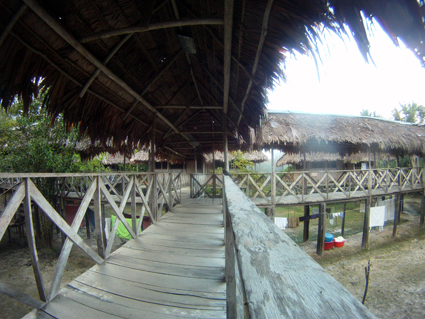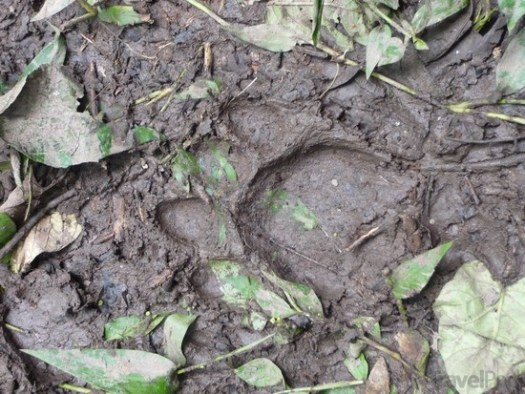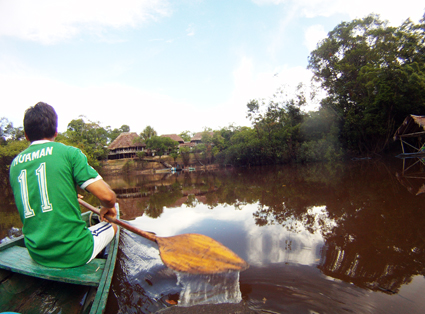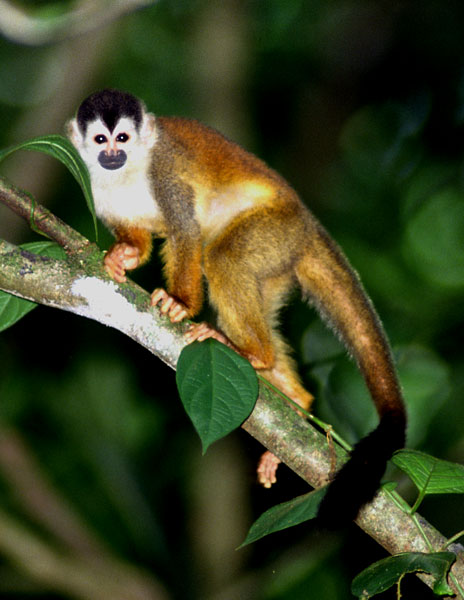At 05:30, shortly before sunrise the Amazonia Research Center wakes up.The chattering sound of people wandering up and down the wooden gangway and in and out their rooms mixes with the sounds of the jungle. At 06:0 it’s breakfast time. Half an hour later, when we leave for another day in the office, the sun has risen.

After a training day on Monday we set up all camera traps, each now surveying a spot within differents cells of 2×2 km in our study area. Thanks to Brigitte and David providing their personal camera traps, nine cameras in total are out in the field to do their job. Furthest away from base are three cameras set up in the terra firme forest. This is “solid earth” forest that never gets flooded. Frankie and David joined Alfredo for a full day hike about six kilometres away from base. That gives you an idea how slow progress in the jungle can be.

Our study area includes different vegetation zones from flooded to seasonally flooded to never flooded areas, palm swamps and islands, so-called ‘restingas’ that stay dry even during the high water season. Different types of animal frequent the various habitats and we are trying, trying, trying to camera trap some of them. Brigitte, Tom and David set up four cameras within the trail grid behind the ARC while Neil went to a trail we’ve recorded last year further up the river. Anh and I set up two cameras on a new trail leading to a lake nearby.

On that first day all teams found jaguar tracks and even a puma track not far behind base! The weather conditions have been pleasant since we’ve started our work. I has not rained for almost three days and the waters in the river have already dropped by a couple of metres.

Survey ‘transect’ walks and canoe surveys up and down the Tahuayo river were our daily routine from Tuesday onwards. Apart from our scientst Alfredo we have Alain, Segundo and Oskar with us. While Alain has been working as an English-speaking jungle guide for nine years at the Tahuayo Lodge, Segundo and Oskar live in El Chino, one of five villages within the Tamshiacu Tahuayo Community Regional Conservation Area (TTCRCA). With their help we were able to spot and identify many, many species and tracks while walking the dense rainforest trails. Their amazing skills include hearing, seeing and smelling animals – there is a lot we can learn from each other.
Sightings of study species so far are saddleback and moustached tamarins, saki monkey, titi monkey, squirrel monkey, brown capuchin monkey. Tracks of jaguar, puma, margay, tayra, porcupine, paca, red brocket deer and white-lipped peccaries have been recorded only to mention a few.

As regards our trailblazing project, we’ve recorded quite a few new trails. Thanks to Segundo who knows the area inside out, we were able to include another cell in our surveys. Starting from the other side of the Tahuayo river just opposite from the trail leading to the lake we’ve explored the forest by having Segundo cutting a way through the forest followed by us carrying all the research equipment for recording the trail and, of course, animal encounters. Although we offered him a GPS to navigate back to the boat, he preferred to rely on his very own sense of direction, which works just as well.
Rotating through the afternoon activities two teams are surveying the river edges from canoes (one going up and one going down the river) while two more teams have been setting up track traps for the last couple of days. By now we have a total of eight track traps set up within the trail grid behind base to be monitored on a daily basis from today onwards.

Continue reading “From our conservation holiday volunteering with jaguars, pumas, ocelots, primates and other species in the Amazon rainforest in Peru, South America (http://www.biosphere-expeditions.org/peru)”

















